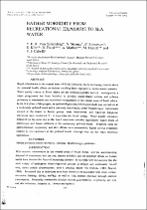JavaScript is disabled for your browser. Some features of this site may not work without it.
- ResearchSpace
- →
- Research Publications/Outputs
- →
- Journal Articles
- →
- View Item
| dc.contributor.author |
Von Schirnding, YER

|
en_US |
| dc.contributor.author |
Strauss, N

|
en_US |
| dc.contributor.author |
Robertson, P

|
en_US |
| dc.contributor.author |
Kfir, R

|
en_US |
| dc.contributor.author |
Fattal, B

|
en_US |
| dc.contributor.author |
Mathee, A

|
en_US |
| dc.contributor.author |
Franck, M

|
en_US |
| dc.contributor.author |
Cabelli, VJ

|
en_US |
| dc.date.accessioned | 2007-03-14T06:45:29Z | en_US |
| dc.date.accessioned | 2007-06-07T10:09:38Z | |
| dc.date.available | 2007-03-14T06:45:29Z | en_US |
| dc.date.available | 2007-06-07T10:09:38Z | |
| dc.date.issued | 1993 | en_US |
| dc.identifier.citation | Von Schirnding, YER, et al. 1993. Bather morbidity from recreational exposure to sea-water. Water Science and Technology, vol. 27, March, pp 183-186 | en_US |
| dc.identifier.issn | 0273-1223 | en_US |
| dc.identifier.uri | http://hdl.handle.net/10204/1885 | en_US |
| dc.identifier.uri | http://hdl.handle.net/10204/1885 | |
| dc.description.abstract | Rapid urbanisation in the coastal areas of South Africa has led to increasing concern about the potential health effects on bathers resulting from exposure to contaminated seawater. Water quality criteria in South Africa are not epidemiologically derived; consequently a major programme has been launched to develop health-related criteria and policies pertaining to wastewater and storm water management in the coastal areas of South Africa. In the first phase of the project, an epidemiological-microbiological study was carried out at a moderately polluted beach and a relatively clean beach, in the Western Cape. Individuals present at the beach in family groups were interviewed and follow-up telephone interviews were conducted 3-4 days after the beach outing. Water quality indicators measured on the same day as the beach interviews revealed significantly higher levels of enterococci and faccal coliforms at the moderately polluted beach. Symptom rates for gastrointestinal, respiratory and skin effects were substantially higher among swimmers relative to non-swimmers at the polluted beach, although they did not reach statistical significance. | en_US |
| dc.format.extent | 192666 bytes | en_US |
| dc.format.mimetype | application/pdf | en_US |
| dc.language.iso | en | en_US |
| dc.publisher | Pergamon-Elsevier Science Ltd | en_US |
| dc.rights | Copyright: 1993 Pergamon-Elsevier Science Ltd | en_US |
| dc.subject | Marine pollution | en_US |
| dc.subject | Bather morbidity | en_US |
| dc.subject | Seawater | en_US |
| dc.subject | Epidemiology | en_US |
| dc.title | Bather morbidity from recreational exposure to sea-water | en_US |
| dc.type | Article | en_US |
| dc.identifier.apacitation | Von Schirnding, Y., Strauss, N., Robertson, P., Kfir, R., Fattal, B., Mathee, A., ... Cabelli, V. (1993). Bather morbidity from recreational exposure to sea-water. http://hdl.handle.net/10204/1885 | en_ZA |
| dc.identifier.chicagocitation | Von Schirnding, YER, N Strauss, P Robertson, R Kfir, B Fattal, A Mathee, M Franck, and VJ Cabelli "Bather morbidity from recreational exposure to sea-water." (1993) http://hdl.handle.net/10204/1885 | en_ZA |
| dc.identifier.vancouvercitation | Von Schirnding Y, Strauss N, Robertson P, Kfir R, Fattal B, Mathee A, et al. Bather morbidity from recreational exposure to sea-water. 1993; http://hdl.handle.net/10204/1885. | en_ZA |
| dc.identifier.ris | TY - Article AU - Von Schirnding, YER AU - Strauss, N AU - Robertson, P AU - Kfir, R AU - Fattal, B AU - Mathee, A AU - Franck, M AU - Cabelli, VJ AB - Rapid urbanisation in the coastal areas of South Africa has led to increasing concern about the potential health effects on bathers resulting from exposure to contaminated seawater. Water quality criteria in South Africa are not epidemiologically derived; consequently a major programme has been launched to develop health-related criteria and policies pertaining to wastewater and storm water management in the coastal areas of South Africa. In the first phase of the project, an epidemiological-microbiological study was carried out at a moderately polluted beach and a relatively clean beach, in the Western Cape. Individuals present at the beach in family groups were interviewed and follow-up telephone interviews were conducted 3-4 days after the beach outing. Water quality indicators measured on the same day as the beach interviews revealed significantly higher levels of enterococci and faccal coliforms at the moderately polluted beach. Symptom rates for gastrointestinal, respiratory and skin effects were substantially higher among swimmers relative to non-swimmers at the polluted beach, although they did not reach statistical significance. DA - 1993 DB - ResearchSpace DP - CSIR KW - Marine pollution KW - Bather morbidity KW - Seawater KW - Epidemiology LK - https://researchspace.csir.co.za PY - 1993 SM - 0273-1223 T1 - Bather morbidity from recreational exposure to sea-water TI - Bather morbidity from recreational exposure to sea-water UR - http://hdl.handle.net/10204/1885 ER - | en_ZA |






